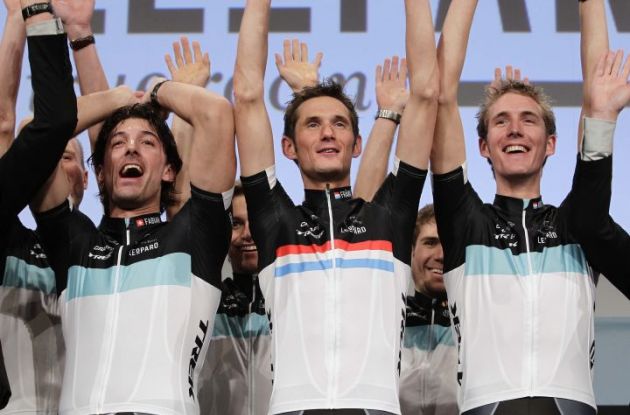UCI Investigating Frank Schleck's Criterium International Win
Cycling's governing body, the UCI, will investigate whether Frank Schleck broke competition rules by wearing a CamelBak drink pack on his chest that might have given the Luxembourg rider an aerodynamic advantage in his 2011 Criterium International victory last month.
Cycling's governing body, the UCI, will investigate whether Frank Schleck broke competition rules by wearing a CamelBak drink pack on his chest that might have given the Luxembourg rider an aerodynamic advantage in his 2011 Criterium International victory last month.
Schleck wore the bag during the third and final stage, a 7-kilometer time trial. He finished 12th and thereby managed to hold onto the overall race lead.
Quite a few pro cyclists have used CamelBak hydration systems in the past and Schleck, who was using it for the first time in a race, was allowed to start the stage by UCI race officials. However, previous riders have worn the CamelBak aerobaks and racebaks on the back and not on the chest.
Former US pro cyclist and Olympic bronze medalist Bobby Julich wore a CamelBak AeroBak in his Tour de France time trials of the late 1990es and wore a CamelBak RaceVest under his skinsuit during the 2004 Olympic Time Trial - in which he won the bronze medal - and in the time trials of the 2004 Tour de France. Julich later became official spokesman for CamelBak.
Italian newspaper La Gazzetta dello Sport first reported the case and said the bag can give an aerodynamic advantage of 2 seconds per kilometer in a time trial.
"An investigation will be launched, so we'll find out what exactly happened. We want to know if there was a breach of the rules," UCI spokesman Enrico Carpani said in a statement.
Schleck's Leopard-Trek team said the rider, who is not known for his time trial abilities, didn't use the bag to reduce air resistance or to improve his aerodynamics.
"We are surprised by all the buzz surrounding this," Team Leopard-Trek spokesman Tim Vanderjeugd commented and added "This is not new, and Frank used the Camelbak's hydration bags to hydrate himself. Even during short time trials, it's important to drink."
Experts, however, question the need and effects of in-race hydration during such short time trials as the 7 kilometer Criterium International time trial in question. It is more important to hydrate properly in the hours leading up to the time trial and during the warm-up phase.
Vanderjeugd said he consulted the UCI's documentation regarding drink packs and was adamant the team is in line with UCI rules.
"The system is allowed if it doesn't change the shape of the body, which was the case with Frank," Vanderjeugd said. "And the aerodynamics effects are yet to be proved, otherwise everybody would use it."
This statement, however, appears questionable, since all new ideas take time to become widely used and popular. So the new idea of wearing a CamelBak hydration pack on the chest instead of on the back may very well have an aerodynamic effect and still only be used by very few riders at this point during the innovation cycle.
The effects of filling the Camelbak hydration pack with air or helium and wearing it on the chest during a race have yet to be investigated.
Vanderjeugd said that Frank Schleck rode with the CamelBak drink pack on his chest to figure out whether he will use the device during the 2011 Tour de France in July.
"We want to assess the system ahead of the big races, to see if it can be efficient," Vanderjeugd said.
Another Team Leopard-Trek rider, Swiss cyclist Fabian Cancellara, was accused last month of using a revolutionary system on his bike that gave him a substantial advantage over his rivals when racing.








